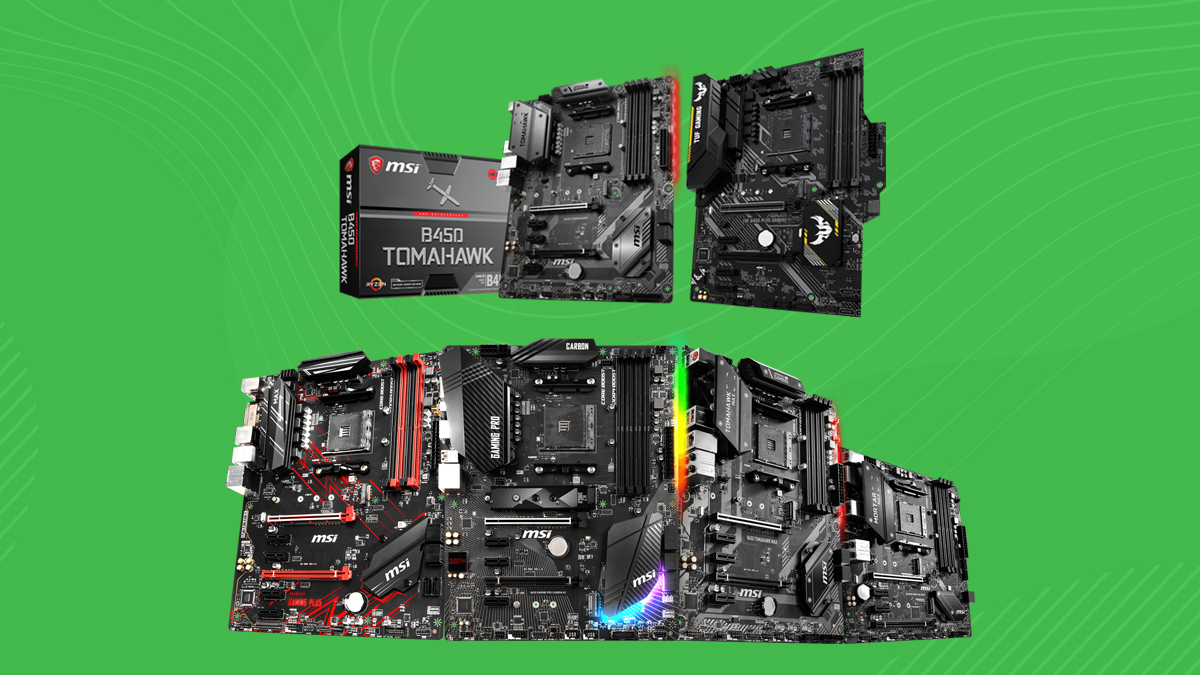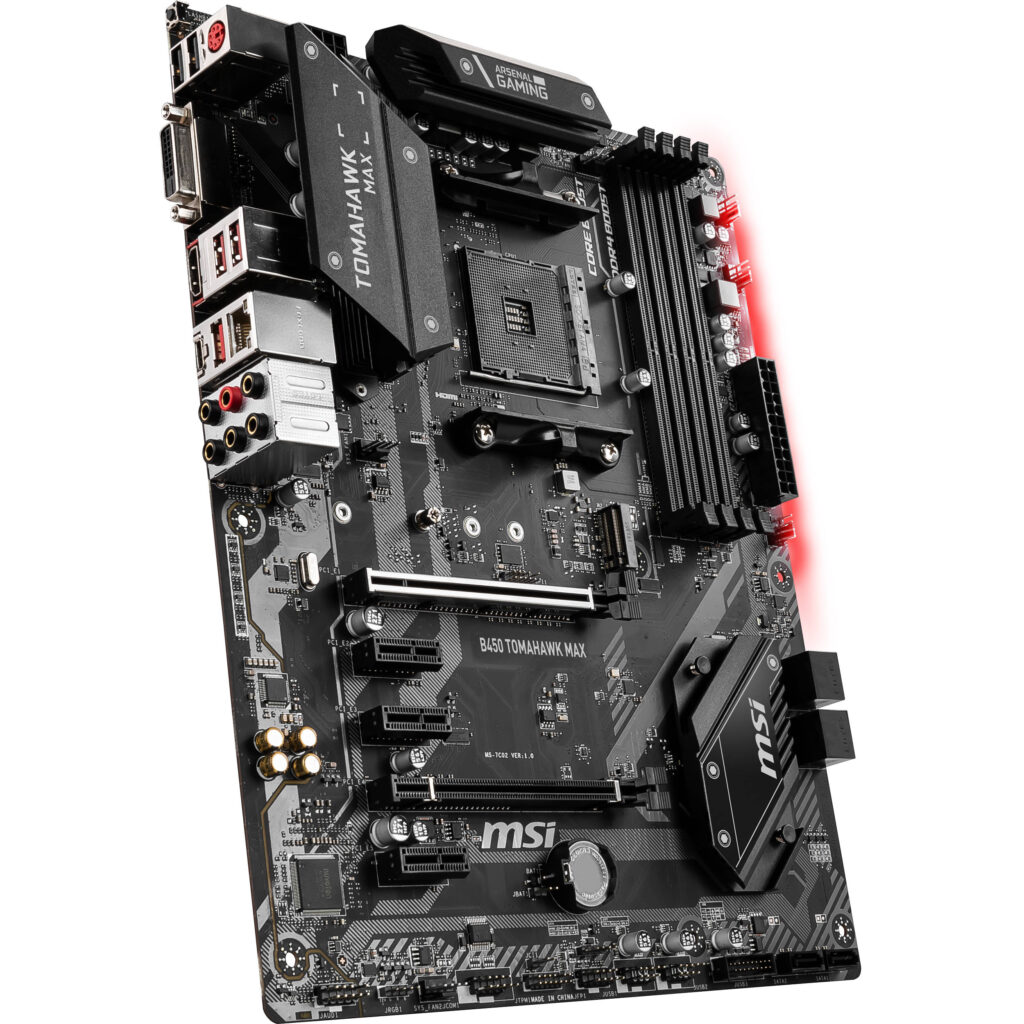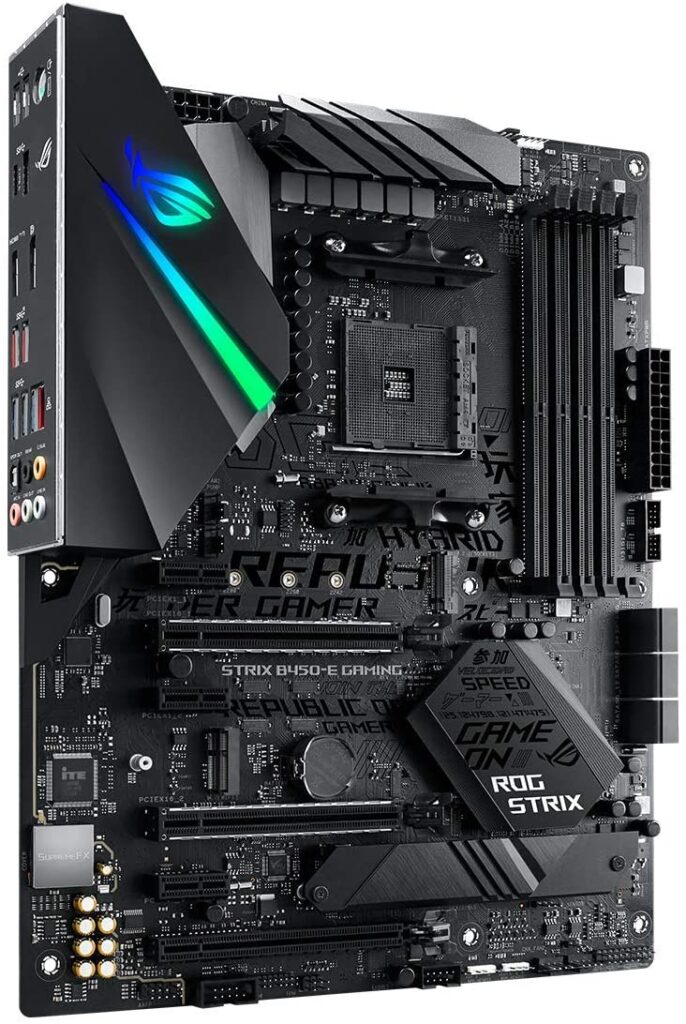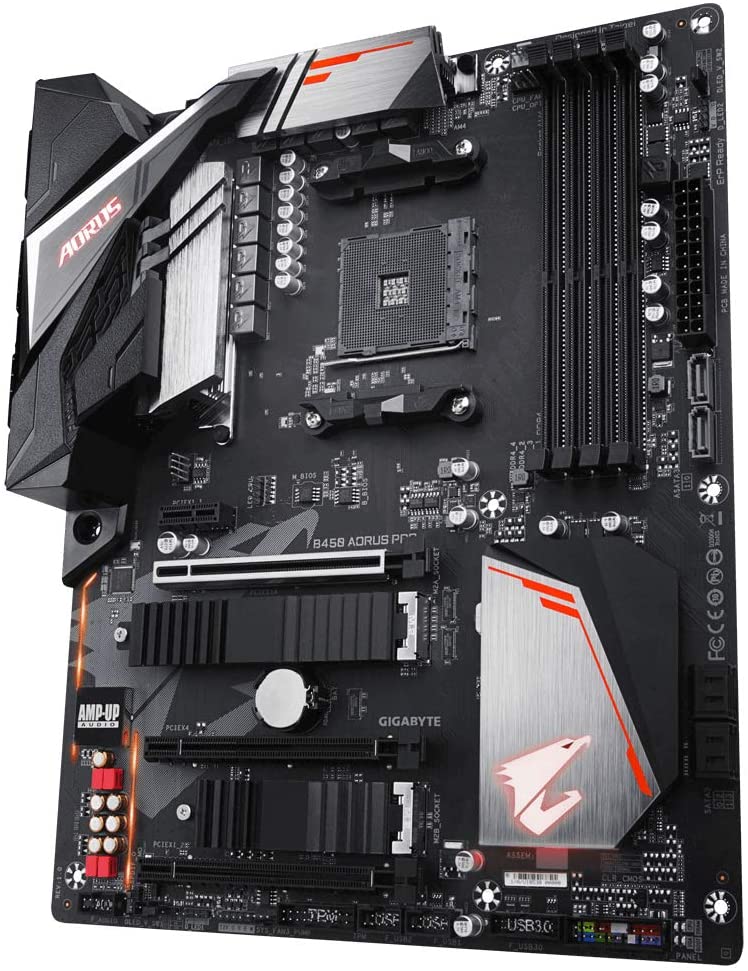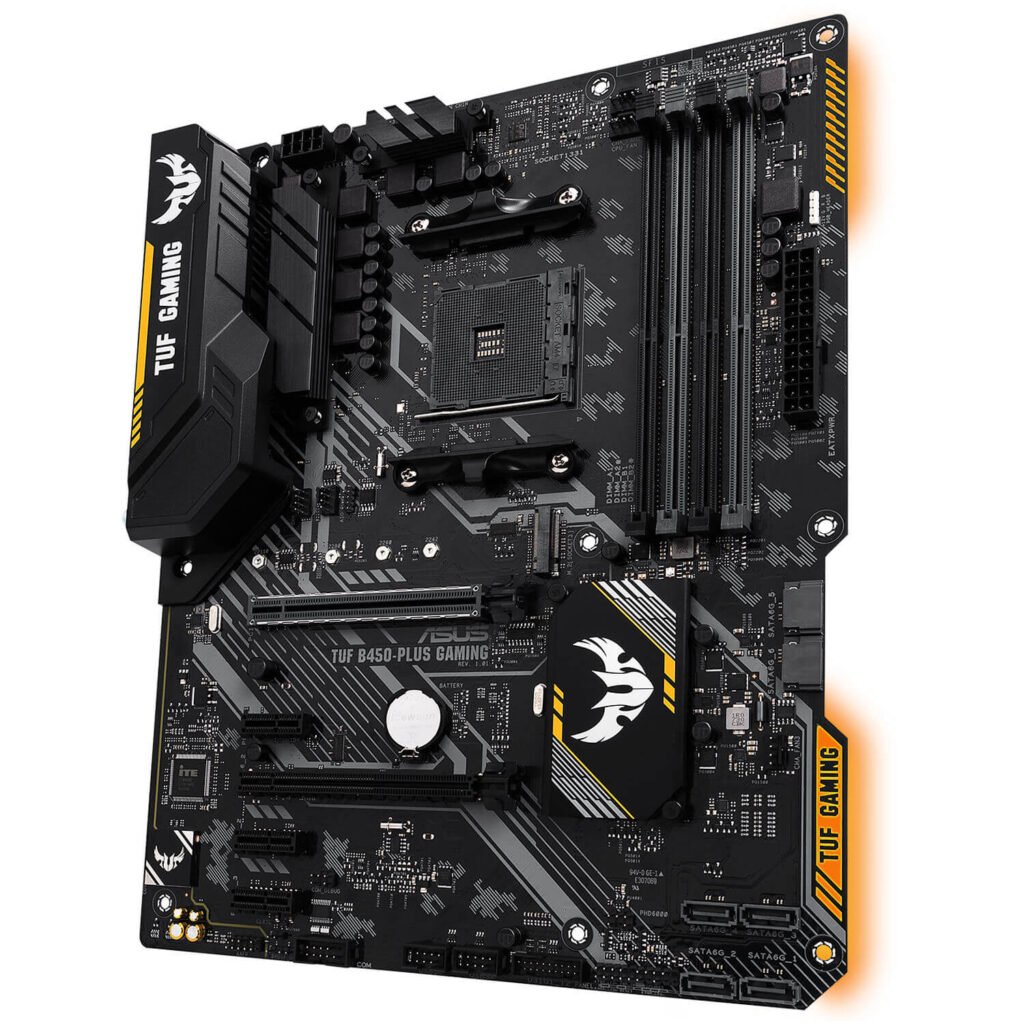The extraordinary CPU compatibility is not the only thing that B450 excels at. Most of the motherboards of this chipset are quite affordable and, therefore, offer excellent value when compared to newer options such as B550 and X570. Not only that, but the B450 chipset also supports overclocking which means that you are not really losing a whole lot if you choose B450 over X570 in favor of some savings. One big drawback of B450, however, is the PCIe Gen 4 support which it lacks, but one can only have so many features at this price point. B450 motherboards still make a lot of sense in 2022 due to their low costs, high compatibility, and diverse feature set.
Best B450 Motherboards of 2022 at a glance
While the choice of the platform is relatively straightforward when it comes to AMD chipsets, choosing a particular motherboard within that chipset is actually more difficult than one might expect. The best B450 motherboard can be different for every single buyer due to differences in preferences and budgets, but there are some boards that are generally accepted by the enthusiast community to be deserving of that title. Following are some of the B450 motherboards that offer something special for the buyers that are looking to buy a B450 motherboard in 2022 for their Ryzen processor. The Tomahawk line has secured a near-legendary status when it comes to AMD motherboards from MSI. The B450 offering in this lineup, the MSI B450 Tomahawk MAX, is no exception as it offers excellent value by combining a top-class VRM design with an affordable price tag that appeals to almost all potential buyers that are looking for a B450 motherboard. Most enthusiasts even classify it as arguably the best B450 motherboard on the market.
The shining star of this motherboard is undoubtedly its exceptional power delivery system as well as its efficient thermal management. MSI has included a very robust VRM in this board that should be able to handle almost all AMD CPUs currently available at the time of writing. This board can even handle overclocked Ryzen 7 CPUs without a hitch, which is more than one can ask for in a budget-oriented motherboard such as the B450 Tomahawk. MSI has also included some hefty VRM heatsinks that keep the temperature of the VRM components in check during intense workloads. The B450 Tomahawk MAX is also decently equipped in the features department. The MAX moniker means that the BIOS ROM size is doubled as compared to the standard Tomahawk, which means that this board has official support for the Ryzen 5000 series in 2022. There is one M.2 slot on the board, however, we feel that MSI could have easily included a second M.2 slot as there is ample free space and the competitors have done it as well. The board also lacks WiFi and the USB ports are somewhat limited in number, which can be a downside for people looking for lots of connectivity options. Still, the excellent pricing of the board makes it an easier pill to swallow. All in all, the MSI B450 Tomahawk MAX can be considered one of the very best B450 motherboards on the market right now, and arguably the best one for CPU overclocking specifically. It has an exceptional VRM design that is hard to find in this price bracket and is priced very competitively which makes it an excellent purchase, despite a few shortcomings in the features department. The ASUS ROG Strix line is the premium lineup from ASUS when it comes to motherboards and their B450 offerings are no exceptions. The ROG Strix B450-E goes head to head with the MSI B450 Tomahawk MAX for the best overall B450 motherboard, which gives further fuel to the MSI vs. ASUS debate. While the MSI offering is a bit cheaper and a bit better when it comes to VRM design, the ASUS option is more well-rounded and a bit more packed with features.
While the B450 motherboards from the ASUS Strix line did have some well-documented problems with their VRM thermal solutions, the Strix B450-E is safe from those issues. Users have to be careful to go for the ASUS ROG Strix B450-E when shopping for the motherboard, and not with the ROG Strix B450-F since that board had terrible VRM performance. The B450-E, however, is one of the top performers in the B450 category and can easily handle overclocked Ryzen 5s and even some Ryzen 7 CPUs without breaking a sweat. From a features perspective, the B450-E from ASUS is probably the most well-equipped board in our lineup. It has WiFi included which is already a huge plus in this category. It also has two M.2 slots which give it the upper hand over the MSI B450 Tomahawk MAX in this department. Aesthetically, the board stands out as well with the traditional aggressive styling that Strix boards are known for. The RGB is quite attractive as well, which is another plus point when it comes to aesthetics. Of course, the lighting can be controlled by ASUS Aura Sync software. Overall, the ROG Strix B450-E might just be the best all-rounder B450 motherboard on the market. While the B450 Tomahawk is a little better in the power delivery department, the B450-E takes the upper hand when it comes to the overall feature set and aesthetics. However, the Strix B450-E is a little more expensive than the Tomahawk which is something to keep in mind. The Gigabyte AORUS line has always impressed with its incredible motherboard offerings and the B450 AORUS Pro seems to be another example of that tradition. It is one of the best B450 motherboards out there when it comes to factors like design, features, and even power delivery. It rivals the top offerings from MSI and ASUS, but it is also priced a bit higher than the ones we have already discussed above.
Under the rather stylish VRM heatsinks, Gigabyte has included a very fine power delivery setup that should have no problems handling Ryzen 5 and Ryzen 7 CPUs even at overclocked settings. This is great news for overclocking enthusiasts who are looking to squeeze every last bit of performance from their CPUs. Furthermore, the VRM heatsinks, apart from being quite attractive, also serve the purpose of effectively cooling the VRM components, which is essential when you are overclocking Zen 3 CPUs aggressively. When it comes to features, the B450 AORUS Pro delivers a middling experience, all things considered. It does have two M.2 slots with some nice heat-spreaders which are always a good addition to any board in 2022. However, it lacks WiFi which can be a bit of a letdown to some users but can be easily rectified with an inexpensive PCIe WiFi card. Aesthetically, the board stands out quite a bit with the use of brushed aluminum accents here and there, complemented by a decent helping of RGB lighting. The lighting is also strategically placed which gives the board a really nice and sophisticated look. The Gigabyte B450 AORUS Pro delivers a solid power delivery system and combines it with a decent feature-set which makes it an attractive B450 option in 2022, however, it is also priced a bit higher than competitors in this category. The standout point of this board is certainly its aesthetics, which is a subjective matter, so that puts it at a bit of a disadvantage compared to the offerings from ASUS and MSI in our list. Still, the B450 AORUS Pro is an excellent option that could be perfect for just the right buyer. ASUS has branded the TUF series to be its value-oriented lineup of motherboards, and the TUF B450-Plus continues that tradition. Not only is it one of the cheaper motherboards in our lineup, but it is also quite an excellent one considering its price point. It ditches some unnecessary bells and whistles which don’t contribute a whole lot to performance and instead lowers the price point to appeal to a wider audience.
When it comes to VRM design and power delivery, the TUF B450-Plus doesn’t particularly stand out among the pack, but it is still more than capable of handling most Ryzen 5 CPUs at overclocked settings. The thermal management of the VRMs is not the very best, but you shouldn’t have any problems with VRM temperatures unless you are creating artificial situations. Overclocking Ryzen 7 and Ryzen 9 parts should be avoided on this motherboard, however, running these CPUs at stock settings should be perfectly fine which is more than one can ask for at this price point. The TUF Gaming B450-Plus is not the best B450 motherboard on our list when it comes to features, but that is to be expected due to the value that this board is targeting. It does not have WiFi and only hosts one M.2 slot, which are both considerable letdowns. As far as looks go, the board is quite simple and understated which can be a good thing or a bad thing depending on the buyer. There are no lighting zones on the board which might be a bummer for some buyers who might want to add a personalized touch to their build. All in all, the ASUS TUF B450-Plus is a great value-oriented motherboard that offers a decent power delivery setup at a competitive price point and should be a good choice for those who are looking to maximize their bang for the buck. It might not have the latest features, but it is certainly not completely barren or outdated in this department either, which is good news for potential buyers. The MSI B450M Mortar is one of those motherboards that seem too good to be true until you dive a little bit deeper into it. It is one of the most impressive B450 motherboards on the market, and certainly the best B450 motherboard in a micro-ATX form factor. Essentially, it is just a compressed B450 Tomahawk with some features added or removed to make a somewhat different product, which is definitely not a bad thing considering the pedigree of the Tomahawk.
Under the substantial VRM heatsinks, we do find a very solid power delivery system that is basically identical to the one found on the B450 Tomahawk. This is excellent news for fans of the micro-ATX form factor since they now have an option to buy a micro-ATX B450 motherboard with a robust VRM design. This power delivery system should be perfectly fine for all Ryzen 5s and even Ryzen 7 CPUs up to the Ryzen 7 3700X, which is a better result than most people would associate with a micro-ATX B450 board. In terms of features, the B450M Mortar MAX is adequately equipped considering the price tag of the board and its micro-ATX form factor. It does have 2 M.2 slots, which is even more than the B450 Tomahawk, despite the latter being a full ATX motherboard. However, the Mortar only has 4 SATA ports and lacks WiFi which are both features that would have been nice additions to this package. Furthermore, the Mortar is often found similarly priced or even more expensive than the B450 Tomahawk MAX on online retail sites, which is unfortunate for the micro-ATX offering in terms of value. Based on these findings, it is clear that the B450M Mortar MAX from MSI is very similar to the B450 Tomahawk, albeit in a smaller form factor. It does have a similar feature set too but is a bit pricy for a micro-ATX board of its class. However, for anyone looking specifically for a B450 Micro-ATX motherboard to pair with your micro-ATX case, it does not get a whole lot better than this.
Factors to Consider While Buying
While shopping for a motherboard in the modern landscape, it is impossible for any novice or even expert PC builder to not get confused by the marketing jargon and meaningless target phrases that are rampant on the product pages of motherboards. The motherboard is a very critical, yet often undervalued component of gaming PCs, and it is very easy to spend way more or way less on a motherboard than you actually should. So, how much should you actually spend on a motherboard? Well, it depends on several factors which should be considered in the purchasing process, some of which are listed below.
VRM Design
For motherboards that support overclocking, such as the B450 motherboards, it is very important to research about the VRM quality of the board that you want to buy. A motherboard’s VRM or power delivery system is tasked with taking the direct power that is coming from the wall and converting it into clean, stable, and usable power for the CPU itself. The VRM design and its thermal management are absolutely crucial in order to get the best overclocking performance from CPUs, and they should definitely be considered in the purchasing process. The size and design of the VRM heatsinks also play an important part in the overall performance of the VRM.
Upgrade Path
Even before you start looking for motherboards on the market, you have to decide what chipset or platform you need to purchase in order to get the best upgrade path down the line. For instance, in the case of Ryzen, AMD has made it very easy for the consumers to upgrade to the next generation without changing the motherboard since they support multiple generations on a single chipset. A B450 motherboard purchased with a Ryzen 2000 series CPU can also be used with your brand new Ryzen 5000 series processor should you choose to upgrade, and that is great when you want to maximize the value proposition. The upgrade path should be mapped out beforehand, and one should choose only the platform that suits your particular preferences in this regard. While these are some of the more critical factors to consider when making a purchase decision about a motherboard, there are certainly many more that also should be in the back of your mind when buying a motherboard. To get an in-depth look at all the factors that you should consider in this process, you can visit our detailed motherboard buying guide, which will help you through the purchasing decision by discussing each and every factor in a comprehensive manner.
Advanced Motherboard Buying Guide – How to Buy A Motherboard For A Gaming PCEarly OnePlus Nord Screens Suffering From Purple-Colored Screen Tint and Other…How to Block Buyers and Bidders on eBay?Gigabyte Adds Support For PCIe 4.0 in Some x470 And B450 boards Through Latest…
